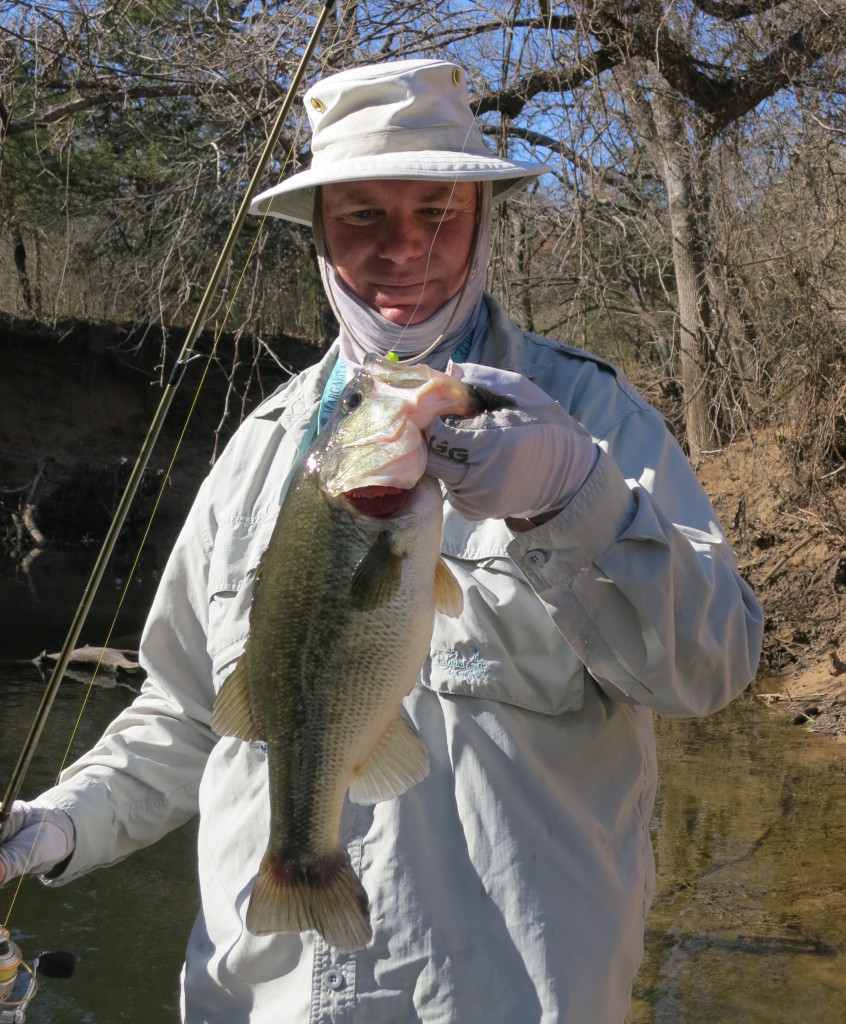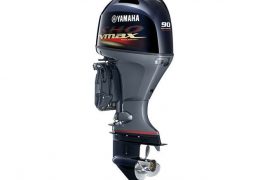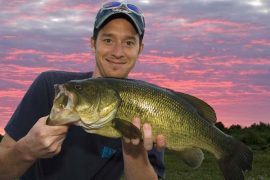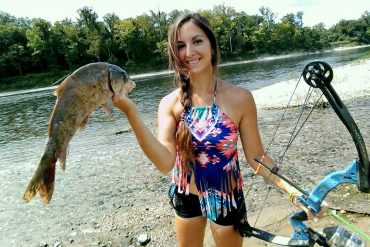Steve Reideler of Denton, Texas, with one of the 28 largemouth bass that he and Rick Allen of Dallas caught on Feb. 24.
Our February guide to Midwest finesse fishing contains 29 logs and 17,814 words that explained how, when, and where Midwest finesse anglers fished in February.
Much of February was unseasonably warm in northeastern Kansas, northwestern Missouri, and central Indiana, as well as several other locales across the nation. For instance, area thermometers climbed to 82 degrees around Lawrence, Kansas, on Feb. 22, and on that date, the surface temperature at one of northeastern Kansas’ community reservoirs climbed to 50 degrees. (What’s more, it was reported by Bill Babler of Blue Eye, Missouri, that the surface temperature at one of the areas that he fished at Table Rock Lake, Missouri, on Feb. 22 hit 60 degrees, and across his 40 years of fishing Table Rock, he has never seen 60-degree surface temperature in February.) Consequently, our traditional wintertime locales and methods bore little to no fruit, and in our eyes and minds, the largemouth bass were often so inscrutable that we struggled and struggled to find and catch a few of them.
This guide features the wintertime endeavors of Rick Allen of Dallas; Norman Brown of Lewisville, Texas; Terry Claudell of Overland Park, Kansas; Paul Finn of Olathe, Kansas, Brent Frazee of Parkville, Missouri; Bob Gum of Kansas City, Kansas; Rick Hebenstreit of Shawnee, Kansas; Pat Kehde of Lawrence, Kansas; Casey Kidder of Topeka, Kansas; Steve Reideler of Denton, Texas; John Thomas of Denton, Texas; Brain Waldman of Coatesville, Indiana, as well as my northeastern Kansas logs.
We are grateful, indeed, that Steve Reideler proof read each log and made them more readable and understandable.
Feb. 1 log
On Feb. 1, I fished one of the many community reservoirs that grace the urban landscapes of northeastern Kansas. And this one is the most heavily fished one of them all.
The Weather Underground reported that it was 34 degrees at 7:53 a.m. and 43 degrees at 12:53 p.m. The wind angled from the north, north by northeast, and northeast at 8 to 23 mph. It was sunny. The barometric pressure was 30.07 at 12:53 a.m., 30.14 at 5:53 a.m., 30.25 at 11:53, and 30.27 at 2:53 p.m.
The water level was several inches above normal. The surface temperature ranged from 38 to 39 degrees. The water exhibited eight to 10 feet of visibility.
In-Fisherman’s solunar calendar indicated that the best fishing would transpire from to 1:42 a.m. to 3:42 a.m., 2:07 p.m. to 4:07 p.m., and 7:55 a.m. to 9:55 a.m. I launched the boat at 10:47 a.m., and I was afloat for three hours and 53 minutes.
David Harrison of Lawrence, Kansas, and I spent 91 minutes fishing this reservoir on Jan. 27, and we failed to elicit a strike, which provoked us to leave and fish another community reservoir, where we eked out 27 largemouth bass in 139 minutes. And on my Feb. 1 outing, I fished for 233 minutes without garnering a strike. But during a 79-minute blitzkrieg, I caught 51 largemouth bass.
These largemouth bass were located in the back portions of a secondary feeder-creek arm. They were abiding in six to 10 feet of water along a 100-foot stretch of a shoreline that is adjacent to this feeder-creek arm’s shallow-water and silt-laden flat. This shoreline possesses a 45-degree slope. Portions of this flat and shoreline are embellished with a few scrawny and scattered patches of Eurasian milfoil and a few other kinds of submerged aquatic vegetation, which I could not identify when I examined this area with an underwater camera. Before it becomes silt-laden, the underwater terrain of the shoreline consists of some rocks and boulders, and the water’s edge is littered with several laydowns and some patches of winter-dead American water willows. Some of the laydowns stretch into 10 feet of water.
I caught one of the largemouth bass on a 2 1/2-inch Z-Man Fishing Products’ Junebug ZinkerZ affixed to a chartreuse 1/16-ounce Gopher Tackle’s Mushroom Head jig. I caught five of them on a 2 1/2-inch Z-Man’s California craw ZinkerZ affixed to a red 1/16-ounce Gopher jig. I caught 13 largemouth bass on a Z-Man’s prototype green-pumpkin finesse creature bait that was affixed to a chartreuse 1/16-ounce. And I caught 39 largemouth bass on a slightly bigger Z-Man’s prototype green-pumpkin finesse creature bait that was affixed to a chartreuse 1/16-ounce Gopher jig.
These two prototypes are similar to Chuck Woods’ great Puddle Jumper, which was made by Mar-Lynn Lure Company of Blue Springs, Missouri, and it used to be a staple for some Midwest finesse anglers in the 1970s. They are also a miniaturized version of Z-Man’s Boar HogZ.
I retrieved the ZinkerZ rigs and prototype rigs with a swim-glide-and-shake presentation.
Three of the 51 largemouth bass were caught adjacent to a laydown, but the other 48 were situated from 10 feet to 90 feet from a laydown.
On ten consecutive casts and retrieves, I caught a largemouth bass. There were spells when I caught two, then three, and then four largemouth bass in a row. I have never in all of my 77 years witnessed such an onslaught.
I fished this 100-foot stretch of water twice. After the first session, I spent some time examining it with an underwater camera, and I saw several largemouth bass milling about, which was the first time that I had ever seen largemouth bass with an underwater camera in northeastern Kansas’ flatland reservoirs.
After I examined it with the underwater camera, I searched in vain to find another bountiful largemouth bass lair in this feeder-creek. I also failed to find one in the back portions of another secondary feeder-creek arm and a tertiary feeder-creek arm.
During my first go around, I fished this stretch of water for 34 minutes, and I caught 23 largemouth bass. I fished it for 45 minutes the second time, and I caught 27 largemouth bass.
My daily piscatorial mission is to catch 25 largemouth bass or smallmouth bass an hour, and I do not care what size they are. I am as pleased to catch a 10-inch largemouth bass as I am to catch an 18-incher. But I must confess that I was wowie-zowied by the size of many of the specimens that I caught along this 100-yard stretch of water. In fact, according to my best recollections, I have never caught so many 2 1/2- to nearly four-pounders in an outing.
It was just one of those serendipitous events that fell into my lap. I do not possess piscatorial savvy to create catches like that. So, I readily admit that it would have been a totally bankrupt outing if I had not by happenstance somehow crossed paths with this massive aggregation of largemouth bass. And as I ponder about it, I have no idea how I happened to cross paths with them. Across the decades that I have fished this reservoir and this particular 100-stretch of water, I suspect that until this bonanza that I had caught a total of about 25 largemouth bass. Thus, in my mind, it is normally a lackluster spot, and consequently, I do not fish it very often. But for some unknown reason, I fished it on Feb. 1, and it yielded a bonanza. It is another one of those mysteries of life.
Feb. 1 log
Steve Reideler of Denton, Texas, posted a log on the Finesse News Network about his Feb. 1 outing.
Here is an edited version of his log:
John Thomas of Denton and I fished at a heavily fished U.S. Army Corps of Engineers’ hill-land reservoir in north-central Texas on Jan. 30. We spent four hours in a small feeder-creek arm located on the north end of the reservoir struggling to catch 12 black bass.
On Feb. 1, many of the waterways in north-central Texas were still muddy from a couple of mid-January thunderstorms. Therefore, Rick Allen of Dallas and I decided to return to the one Corps’ reservoir where the water conditions are improving. Our goal was to locate a large aggregation or two of black bass in the same small feeder creek that John Thomas and I fished on Jan. 30.
It was a delightful and picturesque day for February. The sun shone brightly in a powder-blue sky. The morning low temperature was 40 degrees and the afternoon high temperature reached 75 degrees. The average low temperature for Feb. 1 in north-central Texas is 33 degrees and the average high temperature is 54 degrees. The wind was mild-mannered out of the southwest and northwest at 5 to 7 mph. The barometric pressure was 29.90 at 11:53 a.m. and 29.87 at 3:53 p.m.
In-Fisherman’s solunar calendar indicated that the most productive fishing periods would occur from 1:48 a.m. to 3:48 a.m., 8:00 a.m. to 10:00 a.m., and 2:13 p.m. to 4:13 p.m. Rick and I were afloat from about noon to 4:00 p.m.
We started fishing about 50 yards inside the mouth of the feeder creek and fished our way upstream. This endeavor encompassed about 1 1/2 miles and ended where it became too shallow to traverse. The last half mile of this creek was new territory for us to explore and fish, and it was a challenge to maneuver the boat over and around many shallow-water obstacles such as gravel bars and large laydowns that were blocking our way.
The shorelines in the lower and middle sections of the creek are fairly flat, and they become steeper and bluff-like in the upper reaches. The underwater terrain changes from clay and gravel in the lower and middle sections to a hard rock bottom with submerged rock ledges in the upper end. Scores of flooded bushes, submerged brush piles, partially-submerged laydowns, and a few submerged stumps adorn a goodly amount of the shorelines.
The water in this creek has cleared significantly during the past couple of weeks. On this outing, it exhibited about 1 1/2 feet to three feet of visibility. The surface temperature varied from 60 to 67 degrees. The surface temperature ranged between 53 and 64 degrees on Jan. 30. According to the Texas Water Development Board, the water level was 0.07 feet above normal pool.
In our eyes, it was an average outing. We caught a bass here and there, but we failed to locate any significant concentrations of black bass. In total, we caught 13 largemouth bass and three spotted bass in four hours. We accidentally caught one large bluegill.
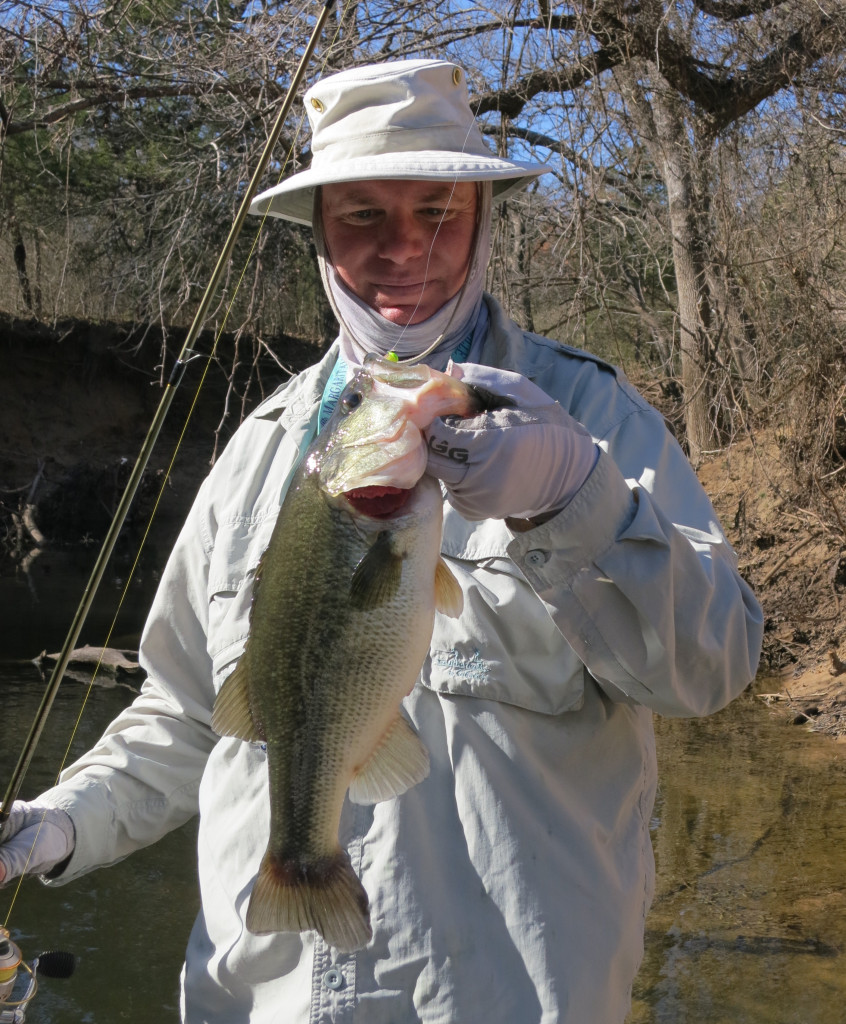
For a short spell, we searched for pre-spawn white bass in the deeper sections of the creek, but we hooked only one that was able to pull free before we could land it.
Most of the black bass were milling about in two to four feet of water and were abiding next to the deepest sides and ends of the larger partially-submerged laydowns. Four of the black bass were caught in the upper reaches of the creek in two to three feet of water, and they were in close proximity to the main creek channel or next to a laydown that was close to the main creek channel. We failed to locate any bass that were associated with any of the submerged stumps, flooded bushes, or submerged brush piles.
A Z-Man’s 2 1/2-inch pumpkin-chartreuse ZinkerZ affixed on a chartreuse 1/16-ounce Gopher jig caught 11 largemouth bass, two spotted bass, and the large bluegill. A 2 1/2-inch Z-Man’s coppertreuse ZinkerZ on a weedless chartreuse 1/16-ounce Bass Pro Shops ball-head jig caught two largemouth bass. One spotted bass was caught on a Z-Man’s green-pumpkin Scented LeechZ attached to a chartreuse 1/16-ounce Gopher jig.
We experimented with all six of the standard Midwest finesse retrieves, but the only effective presentation was a slow swim-glide-and-subtle-shake retrieve.
Rick and I were not the only ones having a difficult day. We spoke to several bass anglers and a crappie angler during our outing. Three bass anglers in one boat who were leaving told us they had caught three largemouth bass. Two other bass anglers in another boat reported that they had caught three small bass. One bass angler in a third boat said that he had enticed only one strike and failed to hook the fish. A crappie angler was fishing from the shoreline and mentioned that he had caught one crappie.
We suspect that some of our fishing woes may revolve around the fact that there are no threadfin shad migrating into any of the feeder creeks, and the presence of threadfin shad is a key element for us to locate and catch significant numbers of largemouth bass, smallmouth bass, spotted bass, and white bass in these Corps’ reservoirs.
Feb. 5 log
Casey Kidder of Topeka, Kansas, filed a brief on the Finesse News Network about his Feb. 5 outing to one of northeastern Kansas’ many community reservoirs.
Here is an edited version of his brief:
We found one short section of a shoreline in the back of a feeder-creek arm loaded with largemouth bass. They were suspended well above the bottom, and a jerkbait was more effective than our Midwest finesse rigs.
We caught 27 largemouth bass in about four hours. Twenty of them were caught on a jerkbait. Seven of them were caught on a Z-Man’s The Deal Finesse T.R.D. affixed to a 1/16-ounce North Metro Bass Academy mushroom-head jig, a Z-Man’s Canada Craw Hula StickZ affixed to a 1/16-ounce mushroom-head jig, and a 1/8-ounce Z-Man’s black/blue ShroomZ Micro Finesse Jig with a black Z-Man’s Scented LeechZ as a trailer. The majority of these largemouth bass were caught along the same shoreline.
We fished some other locales that are normally productive wintertime areas, and we elicited only a couple bites.
The surface temperature was 39 degrees. The water clarity was very good. I could see some winter-killed gizzard shad lying on the bottom in six feet of water at one of the areas that we fished. The water was clear enough that we could see a goodly number of the strikes that we elicited on a jerkbait.
Feb. 7 log
The National Weather Service predicted that area thermometers would climb to 62 degrees on Feb. 7, and Rick Hebenstreit of Shawnee, Kansas, and I dressed according to that forecast when we ventured to one of the many community reservoirs that stipple the exurban landscapes of northeastern Kansas. But to our chagrin, the NWS forecasters missed the mark by 16 degrees, and the chill of the wind penetrated into many of our aged bones. In short, it was not a delightful time to be afloat in northeastern Kansas, and we were the only anglers afloat.
The Weather Underground reported that it was 36 degrees at 3:52 a.m., 46 degrees at 11:52 a.m., and 44 degrees at 12:52 p.m. The wind chill hovered around the mid-30s. The wind angled out of the west by southwest, northwest, west, west by northwest, and north at 8 to 26 mph. The sky fluctuated from being clear to mostly cloudy to partly cloudy to overcast. The barometric pressure was 29.50 at 12:52 a.m., 29.56 at 5:52 a.m., 29.72 at 11:52 a.m., and 29.75 at 2:52 p.m.
The water level was normal. The surface temperature ranged from 39 degrees to 41 degrees. The water clarity exhibited slightly more than five feet of visibility.
In-Fisherman’s solunar calendar indicated that the best fishing would occur from 7:01 a.m. to 9:01 a.m., 7:30 p.m. to 9:30 p.m., and 12:47 a.m. to 2:47 a.m. We fished from 10:30 a.m. to 2:30 p.m.
We spent the entire outing hiding from the wind on a massive flat in the backend of one of this reservoir’s feeder-creek arms. We searched for and focused on patches of curly-leaf pondweed that grace this flat. These patches are scattered across an area that is the size of about six football fields. And we confined our focus along an area the size of about three football fields. We probed water as shallow as two feet and as deep as about eight feet.
Within the first two minutes, we caught one largemouth bass. Then 23 minutes elapsed before we caught another one, and immediately after we caught that second largemouth bass, we caught three more in about six minutes. During the next 25 minutes, we struggled to catch two largemouth bass.
Around 11:20 a.m., we crossed paths with a significant mother lode of largemouth bass that were accompanied by some hefty black crappie. And off and on for the next 193 minutes, we dissected a series of patches of curly-leaf pondweed that encompassed this area that is about 12 yards wide and 60 yards long, and we dissected it from a variety of angles. The depth of the water ranged from three feet to 6 1/2 feet. It yielded 26 largemouth bass and eight crappie. Some of the largemouth bass were extracted out of three feet of water; some were extracted out of 6 1/2 feet of water; some the largemouth bass that we caught were abiding between the depths of three and 6 1/2 feet of water.
During those 193-minutes, we also fished many other yards of this massive flat that were fruitless. But one locale that was about 15 feet wide and 40 feet long yielded seven largemouth bass, but we had to dissect it four times to catch those seven. Another area yielded two largemouth bass. And we caught three largemouth bass that were scattered hither and yon across this vast expanse of water.
During the last two hours of this outing, Rick and I spent a lot of time fishing the way we fished back in the 1970s by wielding a Chuck Woods’ classic three-inch root-beer-glitter Puddle Jumper.
In sum, we caught 46 largemouth bass and inadvertently caught eight crappie. One largemouth bass was caught on a 2 1/2-inch Z-Man’s pearl ZinkerZ affixed to a chartreuse 1/16-ounce Gopher jig. One largemouth bass was caught on a 2 1/2-inch Z-Man’s Junebug ZinkerZ affixed to a blue 1/16-ounce Gopher jig. One largemouth bass was caught on a Z-Man’s green-pumpkin Finesse ShadZ affixed to a chartreuse 1/32-ounce Gopher jig. Fifteen largemouth bass were caught on a three-inch Z-Man’s green-pumpkin prototype finesse-size creature bait affixed to a chartreuse 1/16-ounce Gopher jig. Twenty-eight largemouth bass were caught on the three-inch root-beer-glitter Puddle Jumper affixed to a chartreuse 1/16-ounce Gopher jig.
The Z-Man’s prototype finesse-size creature bait and the Puddle Jumper are somewhat similar, which is why we opted to use the Puddle Jumper. We have only one prototype to work with, and we did not want to over use it and take a chance of losing it.
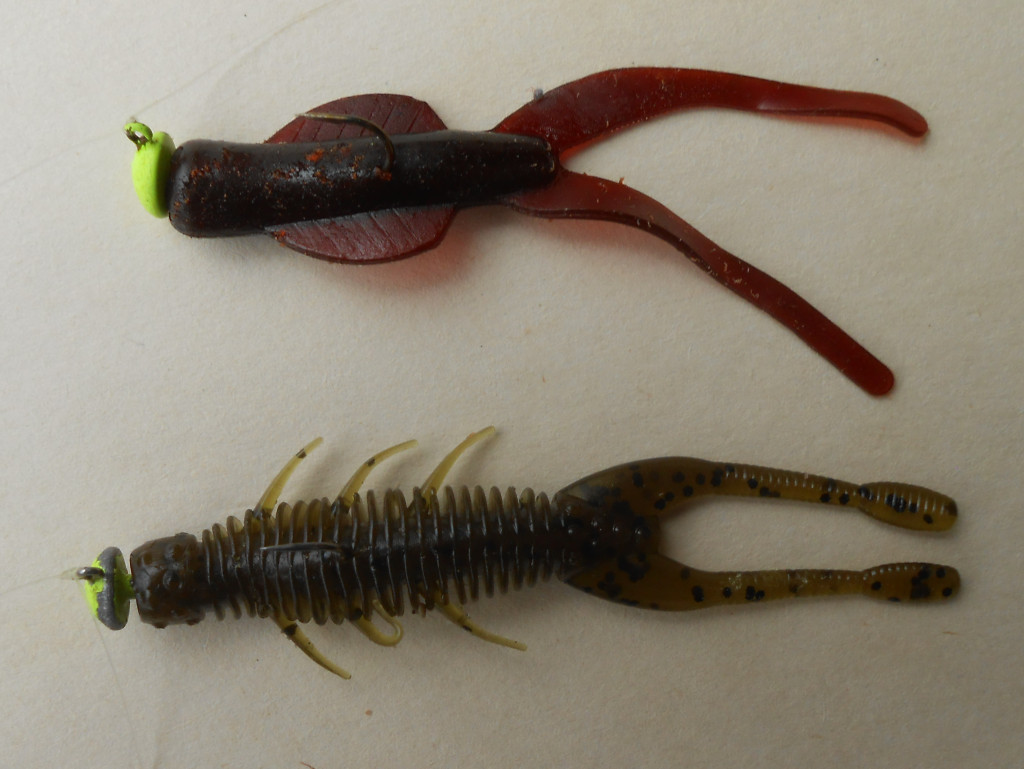
The most effective retrieve was a drag-and-deadstick presentation. Some of the deadsticking routines encompassed six to eight seconds. Three largemouth bass were caught on the initial drop. A few were caught when we employed a swim-glide-and–subtle-shake retrieve. The strikes were extremely subtle; in fact, it seemed as if many of the largemouth bass caught us rather than we catching them.
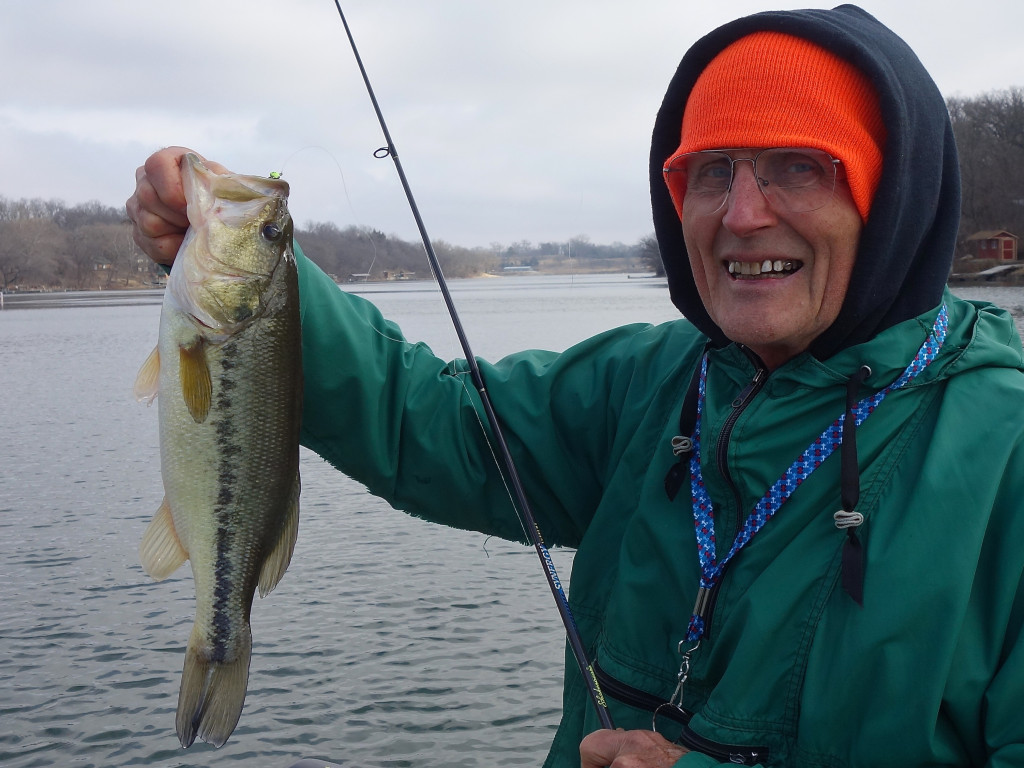
It was a chore finding the whereabouts of the largemouth bass as we made multiple crisscrosses of this massive flat dragging and strolling our Midwest finesse presentations. We had three 20-minute or more spells when we failed to elicit a strike, including the final 20 minutes that we were afloat.
Endnotes to this Feb. 7 log
(1) For more information about Chuck Woods and the Puddle Jumper, please see the Midwest Finesse columns at these links: www.in-fisherman.com/midwest-finesse/the-puddle-jumper-by-chuck-woods/; www.in-fisherman.com/midwest-finesse/legends-of-the-heartland/; http://www.in-fisherman.com/midwest-finesse/a-short-history-of-midwest-finesse-fishing-for-black-bass-1955-2013/.
(2) Here is a link to the Puddle Jumper’s website: http://puddlejumperlures.com/product-category/traditional-puddle-jumpers/page/2/.
Feb. 7 log
Steve Reideler of Denton, Texas, filed a log on the Finesse News Network about his Feb. 7 outing.
Here is an edited version of his log:
From 12:40 p.m. to 4:35 p.m., Rick Allen of Dallas and I fished at a U.S. Army Corps of Engineers’ hill-land reservoir in north-central Texas.
It was another delightful day to be on the water. The morning low temperature was a mild 60 degrees, and during the afternoon, it warmed up quickly to 79 degrees. The sun was radiant in the partly-clouded sky. At 12:02 p.m., the barometric pressure measured 30.01 and dropped to 29.94 by 4:02 p.m. The wind quartered out of the northwest at 10 to 15 mph.
Since January 15, the black bass fishing has been trying in north-central Texas. For instance, John Thomas of Denton and I spent four hours fishing at this reservoir on Feb. 1, and we could barely scrounge up 12 black bass. And on Feb. 6, I visited a community reservoir located in a suburb northwest of Dallas. The fishing was so slow and boring that I could tolerate it for only three hours. And after catching only eight largemouth bass during those three hours, I did not have the wherewithal to post a log about it on FNN. This Feb. 7 outing wasn’t much of an improvement.
According to In-Fisherman’s solunar calendar, the best fishing periods for Feb. 7 would take place from 12:54 a.m. to 2:54 a.m., 7:08 a.m. to 9:08 a.m., and 7:38 p.m. to 9:38 p.m.When we arrived at the boat ramp, we noticed that the water in the vicinity of the boat ramp was muddy with less than a foot of visibility. The water temperature was 54 degrees.
When we arrived at the boat ramp, we noticed that the water in the vicinity of the boat ramp was muddy with less than a foot of visibility. The water temperature was 54 degrees.
We ventured to a small and traditionally fruitful feeder-creek arm that lies along the north end of the reservoir. During the past three weeks, this feeder-creek has had the clearest and warmest water that we have found in any of the many waterways that stipple the north-central Texas countryside. Rick and I shared this creek with eight bass anglers in four boats and two bank anglers fishing for crappie. They reported that none of them had caught more than two black bass.
The water just inside this feeder creek was muddy and exhibited about six inches of visibility. The water temperature was 60 degrees. In the middle riverine section of this creek, the water temperature was 64 degrees and displayed about 1 1/2 feet of clarity. In the upper reaches of the creek, the water was stained with about 2 1/2 to three feet of visibility. The water temperature was 67 degrees.
This creek’s underwater terrain is comprised of clay, gravel, and a few shallow rock ledges. The boat floated in four to 12 feet of water.
We spent the first three hours fishing in the middle of the riverine portion of the creek and we fished our way about a mile upstream. The fishing was as slow and difficult as it was on Feb. 1, and we struggled to catch seven largemouth bass and one spotted bass. We inadvertently caught four white crappie, and one large bluegill.
We decided to fish the last hour of this outing at the mouth of the creek, where we caught three largemouth bass. We were surprised to see a couple of largemouth bass foraging on small threadfin shad along the surface next to some partially-flooded terrestrial vegetation in less than three feet of water. This was the first surface-feeding activity that we have seen this year, and we caught one of those largemouth bass.
In sum, we had difficulty catching 11 black bass in three hours and 55 minutes. They were scattered about and many yards apart from each other. All of them were caught in four to six feet of water.
The most fruitful spots were partially-submerged laydowns that extended from the shoreline out toward the middle of the creek. The laydowns located on steeper shorelines were more fruitful than those situated on flat and shallow shorelines. We failed to catch a bass from any of the shallow rock ledges.
We caught six black bass on a Z-Man’s 2 1/2-inch pumpkin-chartreuse ZinkerZ rigged on either a chartreuse 1/16-ounce Gopher jig or a chartreuse 1/16-ounce Bass Pro Shops weedless ball-head jig. A brown 1/16-ounce Gopher jig dressed with a Z-Man’s Space Guppy Slim SwimZ caught two bass. A 2 1/2-inch Z-Man’s watermelon-red ZinkerZ rigged on a red 1/16-ounce Gopher jig caught two largemouth bass. A Z-Man’s grudgeon CrusteaZ affixed on a chartreuse 1/32-ounce Gopher jig caught one largemouth bass.
The ZinkerZ and CrusteaZ rigs were presented with a slow swim-glide-and-subtle-shake retrieve. The Slim SwimZ combo was retrieved with a slow and steady swimming retrieve.
Our most bountiful winter outing in 2017 occurred at this Corps’ reservoir on Jan. 8, when Rick and I caught 30 black bass in the riverine portions of this creek in three hours and 48 minutes. But since then, we have noticed a significant decline in our catch rates. We suspect that our declining catch rates in this feeder creek may be attributed to the increase in angler predation.
Feb. 10 log
Brent Frazee of Parkville, Missouri, Bob Gum of Kansas City, Kansas, and I ventured on Feb. 10 to a northwestern Missouri community reservoir that lies in the northern suburbs of the Kansas City metropolitan area.
The Weather Underground reported that it was 35 degrees at 12:54 a.m. and 69 degrees at 3:54 p.m. The wind angled out of the south, south by southwest, and southwest at 9 to 29 mph. It was sunny. The barometric pressure was 30.04 at 12:54 a.m., 29.88 at 5:54 a.m., 29.82 at 11:54 a.m., and 29.74 at 3:54 p.m.
The water level was normal. The water exhibited more than six feet of visibility, but around the wind-blown areas, the visibility diminished to 24 inches. The surface temperature ranged from 37 to 38 degrees, and two small areas in the back portions of two of the reservoir’s feeder-creek arms were covered with a thin sheet of ice.
In-Fisherman’s solunar calendar indicated that the best fishing would occur from 9:35 a.m. to 11:35 a.m., 10:02 p.m. to 12:02 a.m., and 3:22 a.m. to 5:22 a.m. We fished from 10:16 a.m. to 3:30 p.m.
While we were afloat, we had no idea that area thermometers were climbing into the high 60s. At times, the wind and cold water chilled us nearly to the bone. What’s more, as we battled the cold wind, we struggled to catch 12 largemouth bass and two rainbow trout.
We attempted to dissect four main-lake areas, but the wind flummoxed those endeavors. Therefore, we spent most of this five-hour-and-14-minute ordeal in the backs of seven wind-sheltered secondary and tertiary feeder-creek arms.
Inside the seven feeder-creek arms that we fished, we found one 150-foot area that yielded five largemouth bass and a 60-foot area that yielded two largemouth bass. The other five largemouth bass were caught hither and yon.
The area that garnered the five largemouth bass lies along a flat near the back of a secondary feeder-creek arm. The boat floated in 10 to 12 feet of water. And we were casting and retrieving a Z-Man’s California craw Hula StickZ affixed to a red 1/32-ounce Gopher jig, a 2 1/2-inch Z-Man’s PB&J ZinkerZ affixed to a black 1/32-ounce Gopher jig, and a 2 1/2-inch Z-Man’s California craw ZinkerZ affixed to a red 1/32-ounce Gopher jig in four to seven feet of water. These five largemouth bass were caught while we were employing a drag-and-slight-deadstick retrieve.
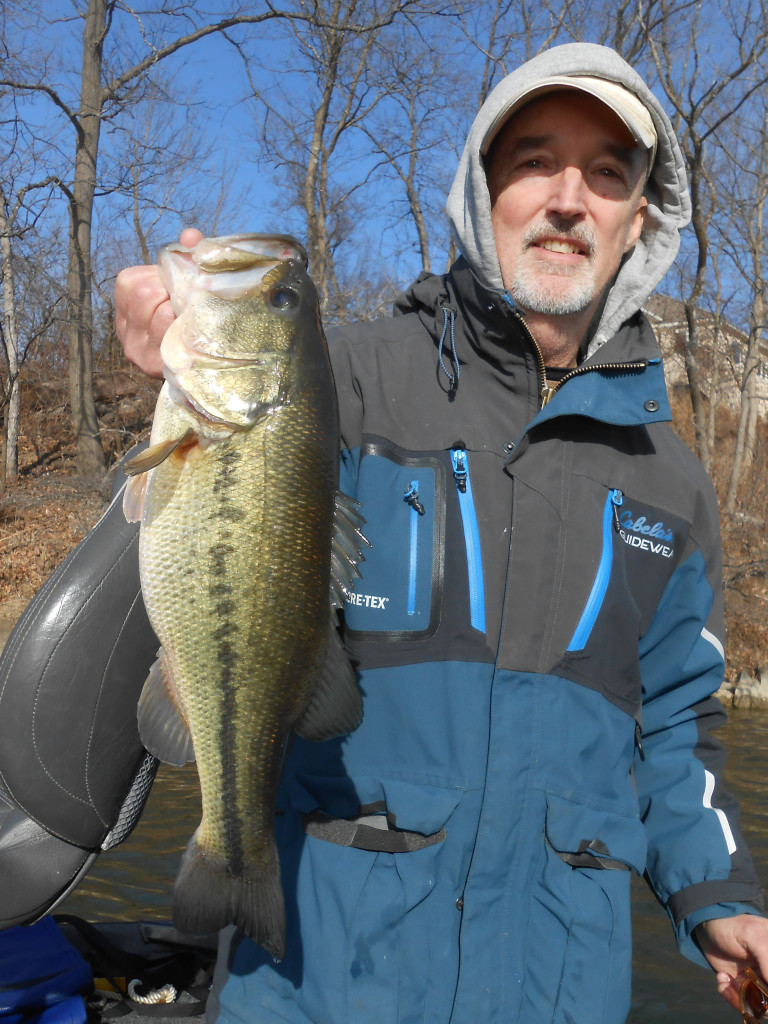
We caught two largemouth bass near the back of a tertiary feeder-creek arm. They were abiding in about five feet of water along a relatively flat shoreline. One was caught on the Z-Man’s California craw Hula StickZ affixed to a red 1/32-ounce Gopher jig with a drag-and-deadstick retrieve. The second one was caught on a Z-Man’s green-pumpkin prototype finesse creature bait affixed to a chartreuse 1/16-ounce Gopher jig with a drag-and-subtle-shake retrieve.
The other five largemouth bass were caught along a hodgepodge of five rocky and boulder-laden shorelines inside five feeder-creek arms. Three of them were caught in three to five feet of water on the Z-Man’s California craw Hula StickZ affixed to a red 1/32-ounce Gopher jig that was strolled behind the boat with a drag-and-deadstick presentation. Two were caught in about four feet of water on the Hula StickZ rig with a drag-and-deadstick presentation.
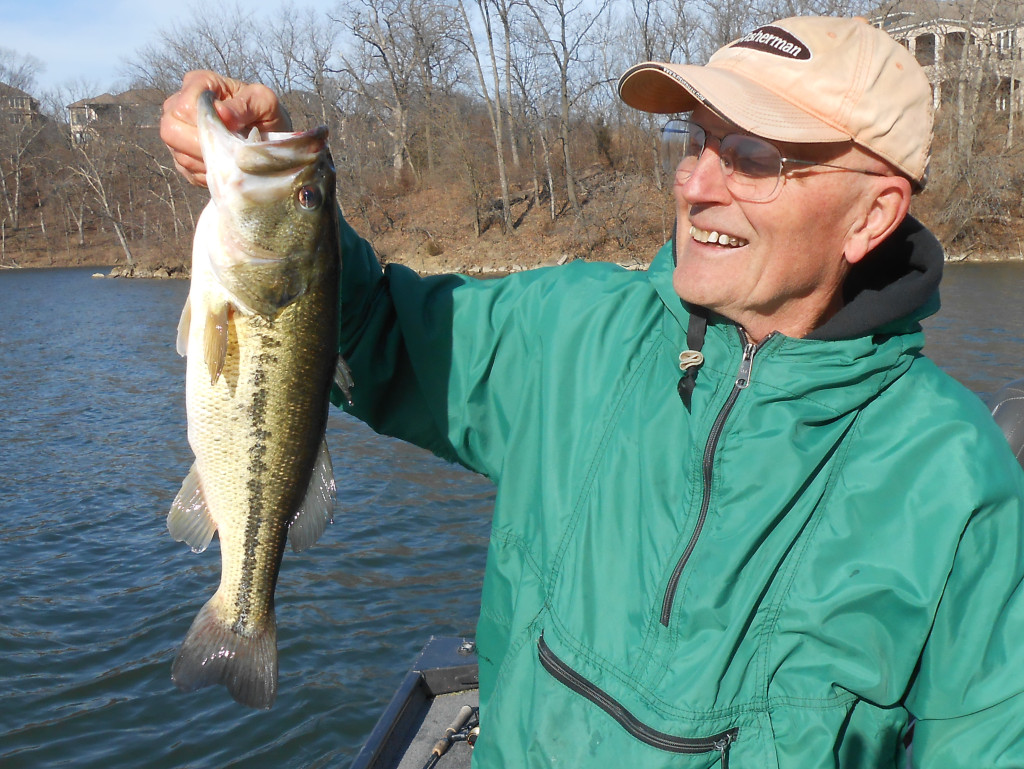
This reservoir used to be graced with bountiful patches of submerged aquatic vegetation, but those patches disappeared several years ago, and since then the cold-water largemouth bass fishing has become problematic.
Across the many years that we have fished the flatland reservoirs of northeastern Kansas and northwestern Missouri, we have found that patches of submerged aquatic vegetation, such as coontail and curly-leaf pondweed, significantly enhance our abilities to find and catch largemouth bass in ice-cold water. Without those patches of aquatic vegetation to focus upon and dissect, our wintertime fishing becomes a random endeavor, and that was what happened to us on this Feb. 10 affair. The three of us had not searched for the largemouth bass in this reservoir since most of the ice melted around the third weekend in January, and to find the largemouth bass’ whereabouts, we suspect that it will take another outing or two that is not blemished with a brisk wind. In short, the combination of wind and no submerged aquatic vegetation is the wintertime anathema for Midwest finesse anglers and their tactics.
Feb. 11 log
Midwest finesse anglers in northeastern Kansas and northwestern Missouri have recently suffered through some woebegone days.
For instance, Bob Gum of Kansas City, Kansas, tried to fish a state reservoir in northeastern Kansas on Feb. 11, but it was afflicted with a terrible euglena bloom, which is a protist, and it is similar to an algae bloom. The water clarity was less than 12 inches. After he fished a flat inside a tertiary feeder-creek with a 2 1/2-inch Z-Man’s Junebug ZinkerZ affixed to a red 1/16-ounce Gopher jig from 8:00 a.m. to 8:20 a.m. without eliciting a strike, he dishearteningly put his boat on the trailer and made the long drive with two other anglers to one of northeastern Kansas’ power-plant reservoirs. They fished from 10:30 a.m. to 3:00 p.m. Ultimately, Gum and his two partners tangled with a combination of 23 largemouth bass and smallmouth bass along the shorelines inside the warm-water outlet. This area was cluttered with scores of boats and anglers. The surface temperature was 69 degrees. Gum and his partners caught these 23 black bass on a 2 1/2-inch Z-Man’s California craw ZinkerZ affixed to a red 1/16-ounce Gopher jig, a 2 1/2-inch Junebug ZinkerZ affixed to a red 1/16-ounce Gopher jig, and a 2 1/2-inch white-blue-flake grub affixed to a 1/8-ounce jig. These black bass were caught in one to four feet of water, and they engulfed the ZinkerZ rigs on the initial drop. The grub was presented with a swimming retrieve. They fished several locales outside of the warm-water area, where the surface temperature was 46 to 47 degrees, and they failed to elicit a strike.
Likewise, Paul Finn of Olathe, Kansas, reported that he and his son spent four hour fishing one northeastern Kansas’ community reservoirs on Feb. 11, and it was affected with a similar affliction of euglena. Finn and his son had only one bite, and it was an eight-inch largemouth bass, which was caught by dragging a Z-Man’s green-pumpkin Finesse T.R.D. TubeZ along the dam. He reported that we “fished all my prime spots and not another bite. We threw all kinds of colors of Z-Man’s 2 1/2-inch ZinkerZs, four-inch Finesse WormZs, and no other bites. I am beginning to think I have lost my touch.” (Lucas Kowalewski is the Kansas Department of Wildlife, Parks and Tourism’s fisheries biologist who oversee this reservoir, and on Feb. 13 he examined the water and found no evidence of euglena.)
Moreover, Casey Kidder of Topeka, Kansas, fished one of northeastern Kansas’ community reservoirs on Feb. 11. He reported that the surface temperature ranged from 36 to 38 degrees. The water clarity was excellent. But he never had a bite. He concluded: “We were a bit befuddled, to say the least. At least we have the snow moon and the comet to blame!”
Brent Frazee of Parkville, Missouri, reported that he and his son fished a community reservoir that lies is the northern suburbs of the Kansas City metropolitan area on Feb. 11, and they struggled and struggled for hours on end to catch three largemouth bass.
Feb. 11 log
Brian Waldman of Coatesville, Indiana, filed a report about his Feb. 11 outing, which included his observations about wintertime largemouth bass in central Indiana.
Here is an edited version of his report:
I have not had much chance to get out fishing this winter. Our weather has been cold and warm, creating multiple freeze-and-thaw cycles that have been tough to time on a working man’s schedule.
In your Jan. 23 log, you wrote: “When the ice melted on Jan. 20, it was the second time that we have had an ice-off phenomenon this winter. And in winter’s past, we have found for some unknown reason that multiple ice-offs are not as bountiful as single ice-offs for catching largemouth bass on the shallow flats in the backs of the feeder-creek arms. Perhaps that is why this outing was so lackluster.”
I would concur with that observation, and it takes place in the flatland reservoirs in Indiana. The pre-ice bite is usually very good here, but once the reservoirs freeze solid for the first time, it seems to both move the fish into their wintering lairs, as well as change their nature to a more passive mood.
Additionally, your Feb. 10 log observation stated: “Across the many years that we have fished the flatland reservoirs of northeastern Kansas and northwestern Missouri, we have found that patches of submerged aquatic vegetation, such as coontail and curly-leaf pondweed, significantly enhance our abilities to find and catch largemouth bass in ice-cold water. Without those patches of aquatic vegetation to focus upon and dissect, our wintertime fishing becomes a random endeavor, and that was what happened to us on this Feb. 10 affair. The three of us had not searched for the largemouth bass in this reservoir since most of the ice melted around the third weekend in January, and to find the largemouth bass’ whereabouts, we suspect that it will take another outing or two that is not blemished with a brisk wind. In short, the combination of wind and no submerged aquatic vegetation is the wintertime anathema for Midwest finesse anglers and their tactics.”
Again, I would concur with this observation as the majority of our flatland impoundments in Indiana do not have submerged vegetation, and our wintertime largemouth bass fishing is always a more modest affair compared to the many logs you have posted with such stellar numbers of fish when you can thoroughly work the large patches of vegetation found in the back of your creek arms.
With all that said, I was able to get afloat on Feb. 11 from 12:30 p.m. to 3:00 p.m. It was aimed more at running the boat so it does not sit idle for another month in the garage. But I also wanted to try and catch a few largemouth bass. In sum, I caught half a dozen largemouth bass on a black marabou jig in three to 10 feet of water.
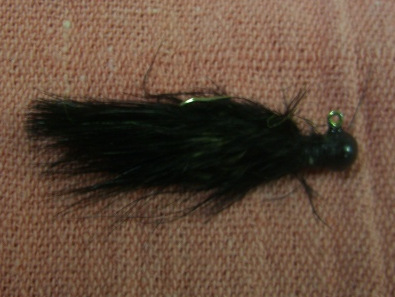
The surface temperature was 39 degrees, and our water exhibited a light stain with about two feet of visibility. Our extended forecast calls for a very nice weekend for mid-February. So, I am hoping to sneak out for a few more hours on at least one of the days.
Feb. 13 log
Steve Reideler of Denton, Texas, filed a log on the Finesse News Network about his Nov. 13 outing.
Here is an edited version of his log:
Feb. 13 was a gray and overcast day. Scattered showers were erupting here and there across the northern sections of Denton. Some meteorologists were forecasting colder temperatures and thunderstorms during the evening hours of Feb. 13, and the cold rain would continue throughout the day on Feb. 14 and into the early morning hours of Feb. 15. I opted to conduct a solo afternoon bank-walking excursion at a community reservoir located in a northwest Dallas suburb. On Feb. 6, I fished this impoundment for three hours, and it yielded only four largemouth bass.
The morning low temperature on Feb. 13 was 44 degrees and the afternoon high temperature was 61 degrees. The wind was steady at 14 mph out of the northeast. The barometric pressure was 30.24 at 11:00 a.m. and 30.08 at 4:00 p.m.
The water level was normal. The water was stained and exhibited about 1 1/2 to two feet of visibility. The water temperature was 60 degrees, and it was 55 degrees on Feb. 6.In-Fisherman’s solunar calendar indicated the most fruitful fishing periods would occur between 6:10 a.m. and 8:10 a.m., 12:21 p.m. to 2:21 p.m., and 11:58 p.m. to 1:58 a.m. I fished from 11:30 a.m. to 3:30 p.m.
In-Fisherman’s solunar calendar indicated the most fruitful fishing periods would occur between 6:10 a.m. and 8:10 a.m., 12:21 p.m. to 2:21 p.m., and 11:58 p.m. to 1:58 a.m. I fished from 11:30 a.m. to 3:30 p.m.
I began by fishing the north end of the reservoir. This area encompasses a large mud flat that is festooned with tall stands of cattails. The east end of this flat is endowed with a small creek. The bottom of the creek is rock-laden and one side of the creek is lined with tall stands of cattails. I caught four largemouth bass around a shallow area of a relatively deep pool in the upper end of this small creek. They were caught in two feet of water on a modified 2 1/2-inch Z-Man’s Junebug FattyZ tube affixed to a chartreuse 1/16-ounce Gopher jig. It was retrieved with a slow drag-and-deadstick presentation.
After I fished the creek, I moved to the east shoreline and worked my way southward toward the dam. The east shoreline is steep and curved. A broad and steep sand and gravel point is situated in the mid-section of this shoreline. About 60 feet north of this point lies a long, clay and gravel point that extends westward toward the middle of the reservoir.
I caught three largemouth bass that were relating to the south side of the long clay and gravel point on the north end of the shoreline. These largemouth bass were abiding in four to six feet of water. They were caught on a 2 1/2-inch Z-Man’s pumpkin-chartreuse ZinkerZ rigged on a brown 1/16-ounce Gopher jig that was retrieved with a slow swim-glide-and-shake presentation.
The broad middle point relinquished six largemouth bass. Five largemouth bass were caught on the 2 1/2-inch pumpkin-chartreuse ZinkerZ rig and one was caught on the modified 2 1/2-inch Junebug FattyZ tube rig. The ZinkerZ rig was presented with a slow swim-glide-and-shake retrieve, and the FattyZ tube rig was retrieved with a slow hop-and-bounce presentation. These six bass were caught in five feet of water.
One largemouth bass was caught in five feet of water next to a sand and gravel ledge along the south end of this shoreline. It was caught on the 2 1/2-inch pumpkin-chartreuse ZinkerZ combo with a swim-glide-and-shake action.
After I finished fishing the east shoreline, I plied the smooth concrete-slab dam that forms the southern perimeter of the reservoir, and I failed to elicit any strikes.
From the dam, I worked my way northward along the west side of the reservoir. The west shoreline is steep and its underwater terrain consists of sand and gravel. A fishing pier is positioned along the middle section of this shoreline. A thin wall of hydrilla runs underneath the fishing pier. This wall of hydrilla is about five feet wide and 35 feet long, and it parallels the shoreline in about eight feet of water. One gravel and sand tertiary point lies about 50 feet south of the fishing pier. Two other tertiary points are located about 30 yards north of the pier. A shallow ditch also adorns the northern end of this shoreline and cuts across the large mud flat on the north end of the reservoir.
The sandy tertiary point south of the fishing pier surrendered three largemouth bass. Two were caught on the 2 1/2-inch Junebug FattyZ tube combo and hop-and-bounce presentation. One was caught on the 2 1/2-inch pumpkin-chartreuse ZinkerZ rig and slow swim-glide-and-shake retrieve. These three bass were caught just off the tip of the point in five feet of water.
The steep sand and gravel shoreline adjacent to the fishing pier yielded three largemouth bass. They were relating to the submerged wall of hydrilla in about eight feet of water. They were caught on the 2 1/2-inch pumpkin-chartreuse ZinkerZ, which was presented in a slow swim-glide-and-shake retrieve.
I caught one largemouth bass in five feet of water from the middle of the ditch on the northeast end of the reservoir. This largemouth was caught on the 2 1/2-inch pumpkin-chartreuse ZinkerZ and swim-glide-and-shake presentation.
All told, the fishing at this impoundment had improved since Feb. 6. I caught 21 largemouth bass in four hours. Three other bass were able to liberate themselves before they came to hand.
Fourteen largemouth bass were caught on the 2 1/2-inch Z-Man’s pumpkin-chartreuse ZinkerZ combo and slow swim-glide-and-shake retrieve. Seven largemouths were caught on the modified 2 1/2-inch Junebug fattyZ tube rig and hop-and-bounce presentation.
We are a bit concerned that the approaching cold rainstorms that are forecast to drench the Dallas and Ft. Worth metropolitan areas will have a negative effect on the water conditions and black bass fishing. Many of the reservoirs in north-central Texas have not yet returned to normal after several severe thunderstorms hit this part of Texas on Jan. 15. The last thing these reservoirs need is more muddy runoff.
Feb. 14 log
On Feb. 11, it was noted in the brief reports by Bob Gum of Kansas City, Kansas, Paul Finn of Olathe, Kansas, Casey Kidder of Topeka, Kansas, and Brent Frazee of Parkville, Missouri, that the largemouth bass fishing has been woeful at several of the community and state reservoirs that grace northeastern Kansas and northwestern Missouri. And I endured some more manifestations of those woes during the three hours and 14 minutes that I fished at one of our community reservoirs in northeastern Kansas on St. Valentine’s Day.
The National Weather Service reported that it was 29 degrees at 6:52 a.m. and 55 degrees at 3:52 p.m. The wind angled out of the north, northwest, and west at 3 to 15 mph. The sun shone through thin layers of clouds. The barometric pressure was 30.09 at 12:52 a.m., 30.06 at 5:52 a.m., 30.05 at 11:52 a.m., and 30.00 at 2:52 p.m.
The water level was normal. The surface temperature ranged from 40 to 41 degrees. The water exhibited four to nearly six feet of visibility.
In-Fisherman’s solunar calendar indicated that the best fishing would transpire from 12:43 a.m. to 2:43 a.m., 1:06 p.m. to 3:06 p.m., and 6:55 a.m. to 8:55 a.m. I fished from 11:30 a.m. to 2:44 p.m.
Traditionally, we can find and catch a significant number of largemouth bass milling about on the flats in three to seven feet of water in the back portions of this reservoir’s feeder-creek arms. For instance, seven days ago Rick Hebenstreit of Shawnee, Kansas, and I caught 46 largemouth bass in four hours on one of the flats in the back of one of this reservoir’s feeder-creek arms. And on Feb. 14, 2014, I caught 4o largemouth bass on this flat in four hours and 10 minutes.
This time around, I spent the entire outing either strolling or employing a drag-and-deadstick presentation with a 2 1/2-inch Z-Man’s California craw ZinkerZ affixed to a red 1/16-ounce Gopher jig, a 2 1/2-inch Z-Man’s Junebug ZinkerZ affixed to a chartreuse 1/32-ounce Gopher jig, a three-inch Z-Man’s green-pumpkin prototype creature bait affixed to a chartreuse 1/16-ounce Gopher jig, and a three-inch root-beer-glitter Puddle Jumper affixed to a chartreuse 1/16-ounce Gopher jig.
I used these baits and presentations along portions of the shorelines and across the flats inside two feeder-creek arms. And to my disappointment, I struggled to catch six largemouth bass on the 2 1/2-inch Z-Man’s California craw ZinkerZ affixed to a red 1/16-ounce Gopher jig and two largemouth bass on a three-inch Z-Man’s green-pumpkin prototype creature bait affixed to a chartreuse 1/16-ounce Gopher jig.
These largemouth bass were extracted out of five to seven feet of water. Two of…

